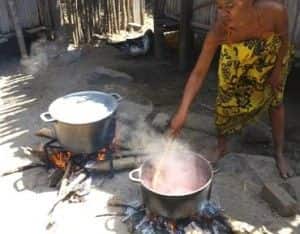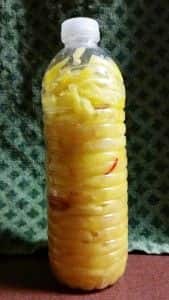Jon Martinek went on the Whole Foods Market Team Member Volunteer trip to Madagascar in 2015 – below, he shares a recipe he picked up along the way!
 The staple foods of rural Madagascar are humble rice and beans cooked over an open fire with little seasoning beyond salt, onions and occasionally fresh made coconut milk. These hearty foods of the “poverty kitchen” are enhanced with fiery condiments such as sakay (ginger/chili paste) and lasary manga.
The staple foods of rural Madagascar are humble rice and beans cooked over an open fire with little seasoning beyond salt, onions and occasionally fresh made coconut milk. These hearty foods of the “poverty kitchen” are enhanced with fiery condiments such as sakay (ginger/chili paste) and lasary manga.
Mango pickles are a ubiquitous condiment, found on tables across Madagascar  and sold at roadside stands in reutilized water bottles. In a land with virtually no refrigeration, fermented foods are necessary to extend the shelf life of perishable fruit and vegetables. A process of lactic fermentation, similar to that used for kimchi and sauerkraut, pickles the mangoes, preserving them, and also enhancing the diet with important nutrients and probiotics. The presence of live cultures produces co2, giving the finished product a carbonated sensation on the tongue.
and sold at roadside stands in reutilized water bottles. In a land with virtually no refrigeration, fermented foods are necessary to extend the shelf life of perishable fruit and vegetables. A process of lactic fermentation, similar to that used for kimchi and sauerkraut, pickles the mangoes, preserving them, and also enhancing the diet with important nutrients and probiotics. The presence of live cultures produces co2, giving the finished product a carbonated sensation on the tongue.
When we were all gifted bottles of our favorite Malagasy pickles by the ladies of our village, we were warned to open the bottles every day to relieve the excess pressure. Some team members forgot this sage bit of advice, resulting in our nickname for these pickles, the “exploding mango cannon!” If you were lucky, you opened the bottle and the pickles leapt from the container like so many fake snakes from a gag can of peanuts. If you were unlucky, you were awoken in the middle of the night by the sound of an explosion, and found yourself in the dark covered with spicy/sweet shrapnel.
If you’re patient and adventurous you can try your hand at making your own lasary manga, with the following recipe that I pieced together from taste memories and a little research into the home pickling process.
Malagasy Mango Pickles
1 lb peeled and seeded mango (hint: slightly under-ripe mangos are better than soft mushy ones)
1 fresh hot red chile (such as Thai bird chile or Italian hot cherry pepper)
2 tsp coarse salt (sea or kosher)
If you have a pickle crock use it! Otherwise get a glass or plastic container and a plate or bowl that is small enough to fit completely inside the vessel. Clean and sanitize everything that will come in contact with your pickles.
Place your pickling vessel in a room temperature location where it will not be disturbed such as a closet or kitchen cupboard. Within a few hours the fruit will exude some of its juices and everything should be completely submerged under the liquid. Stir the mixture every few days with a sanitized spoon before replacing the lid and weight. After a few days you will see bubbles rising from the liquid. Primary fermentation will be complete in just a few days, but the flavor will improve if you let it go for two to three weeks. Transfer the finished pickles to a container such as a Mason or Jelly jar and store in the refrigerator. After a few more days they will develop the characteristic carbonation of authentic Malagasy Mango Pickles. Be careful when opening the jar as the pickles will tend to bubble up suddenly.


